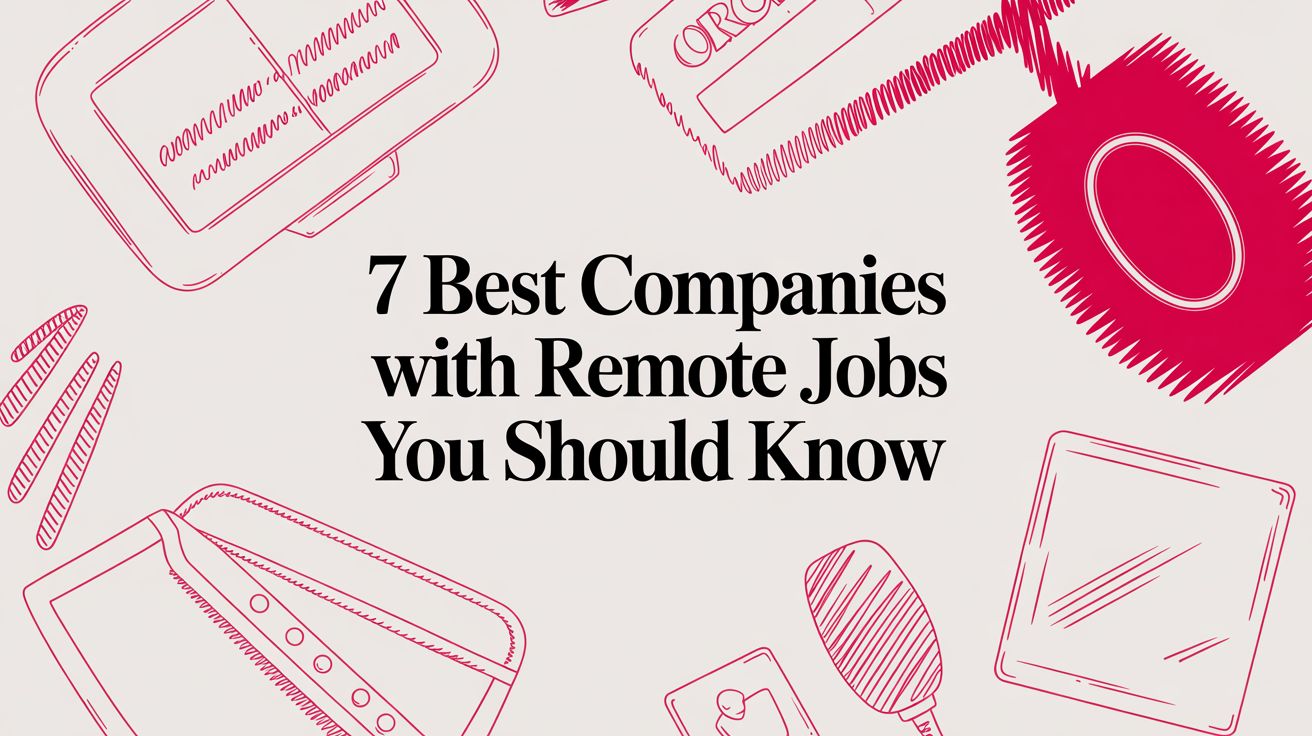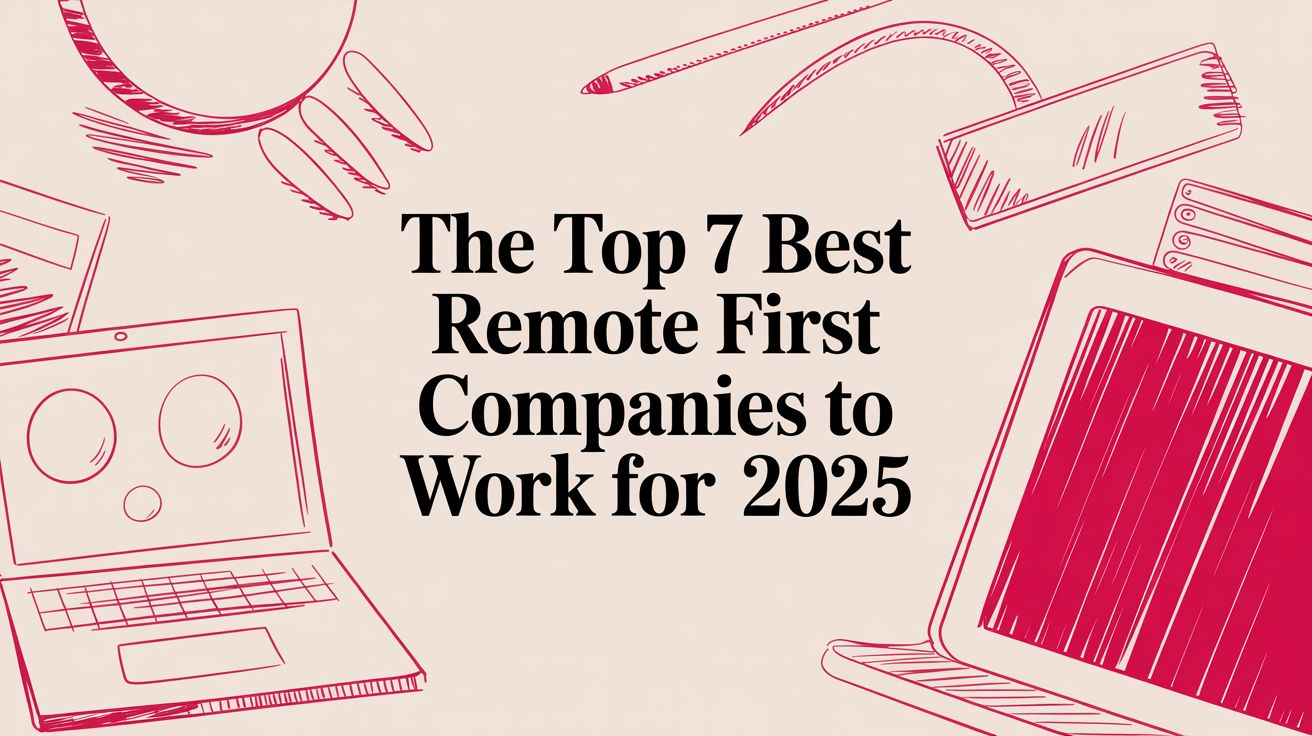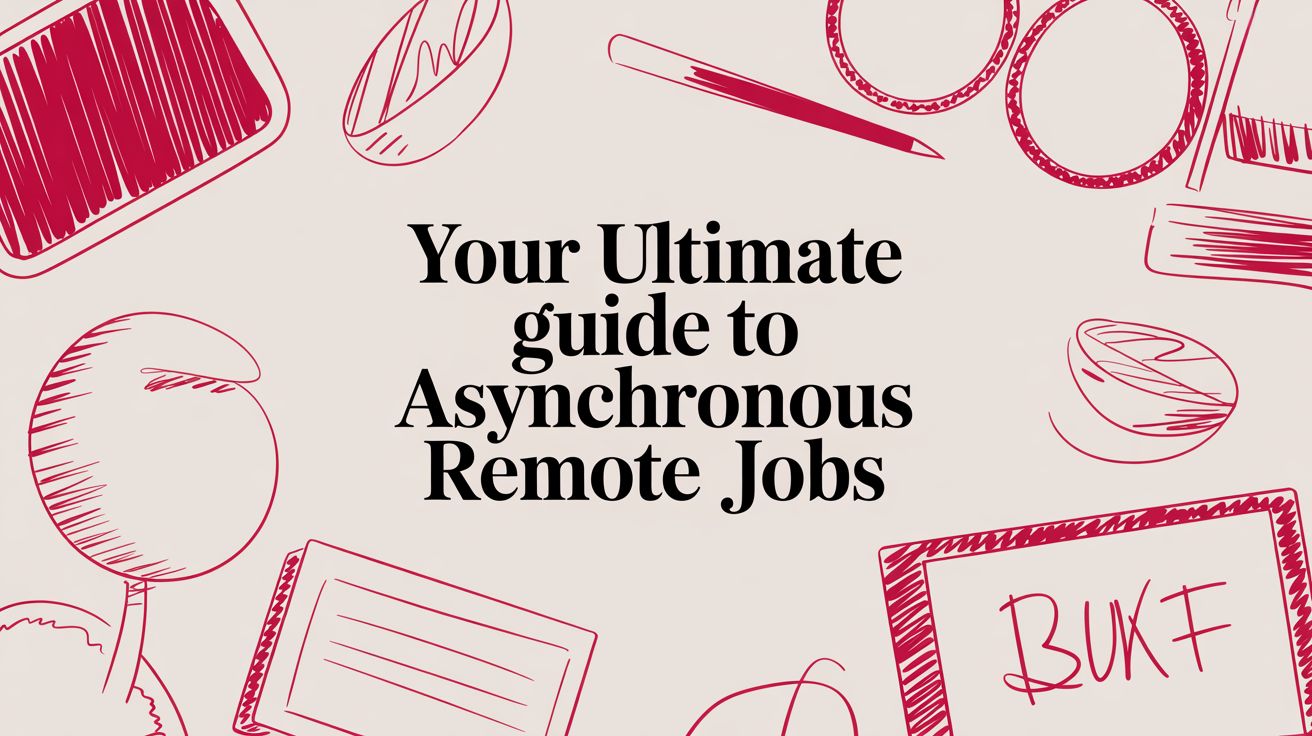Streamlining Recruitment Process for Faster Hiring Success
Max
Let’s be honest: streamlining your recruitment process is about way more than just shaving a few days off your time-to-hire. It’s about swapping out clunky, manual tasks for smart, efficient systems that not only speed things up but also land you better candidates. The goal is to build such a positive experience—from that first click on your job post to the final offer—that you attract and sign top talent before your competitors even get a chance. This whole approach is built on speed, crystal-clear communication, and making decisions with data, not just gut feelings.
Building a Modern High-Efficiency Hiring Funnel
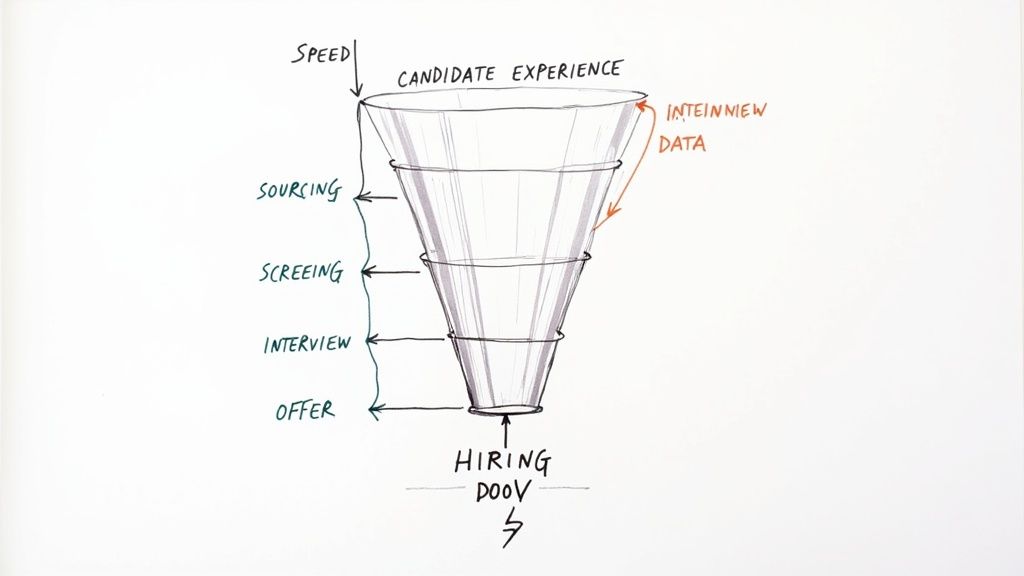 In today’s talent market, speed is the name of the game. The best people are often off the market in just a few weeks. If your hiring process is slow and clunky, you’re practically handing top performers over to other companies. To win, you have to ditch the outdated, manual methods and build a modern, high-efficiency hiring funnel. This isn’t just about moving faster; it’s about creating a smarter system that respects a candidate’s time and gets better results for your team.
In today’s talent market, speed is the name of the game. The best people are often off the market in just a few weeks. If your hiring process is slow and clunky, you’re practically handing top performers over to other companies. To win, you have to ditch the outdated, manual methods and build a modern, high-efficiency hiring funnel. This isn’t just about moving faster; it’s about creating a smarter system that respects a candidate’s time and gets better results for your team.
The foundation of a great system rests on three core pillars:
- Speed and Automation: Get the robots to do the boring stuff. Automate repetitive tasks like screening applications, scheduling interviews, and sending status updates. This frees up your hiring team to focus on what humans do best—building relationships and having meaningful conversations.
- Candidate Experience: Every single touchpoint matters. From the job description they read to the offer letter they sign, every interaction should be clear, professional, and engaging. A fantastic experience can turn a candidate into a brand advocate, even if they don’t get the job.
- Data-Driven Decisions: Stop guessing and start knowing. Tracking key metrics helps you spot bottlenecks in your process, figure out which sourcing channels are actually working, and constantly tweak your approach for better results.
Shifting from Traditional to Modern Recruitment
The real difference between an old-school process and a modern one is the mindset. A traditional approach is often reactive and built around what’s easiest for the company, not the candidate. The modern approach flips that script—it’s proactive and candidate-centric.
To get a better handle on the core principles, digging into talent acquisition best practices can give you a solid strategic foundation. This shift is what turns hiring from a series of disconnected, frustrating steps into a smooth, positive journey for everyone involved.
The table below breaks down exactly what this shift looks like in practice.
Comparing Traditional vs. Streamlined Recruitment Stages
| Hiring Stage | Traditional Approach (Slow & Manual) | Streamlined Approach (Fast & Automated) |
|---|---|---|
| Sourcing | Posting on one or two job boards and waiting for applicants to roll in. | Actively sourcing from multiple channels, including niche communities and talent pools. |
| Screening | Manually reviewing every single resume, one by one. | Using an ATS to automatically filter for keywords and required qualifications. |
| Interviewing | Endless email back-and-forth to schedule a single interview. | Using scheduling tools like Calendly to let candidates book their own time slots. |
| Assessment | Generic take-home projects that take hours and don’t reflect the actual job. | Practical, job-relevant skills tests that are short and to the point. |
| Offer | A slow approval process followed by a generic, text-based email offer. | A quick, personalized offer process, often including a video message from the hiring manager. |
As you can see, the streamlined approach focuses on removing friction at every turn, making the entire experience better for candidates and more efficient for your team.
The goal isn’t just to fill a role quickly. It’s to create an experience so efficient and respectful that the best candidates want to join your team over others, reinforcing your employer brand with every interaction.
This guide will give you a practical framework for building this high-speed funnel. We’ll walk through each stage, from sourcing all the way to onboarding, and give you actionable tips to cut out delays and make your process more effective. By the end, you’ll have a clear roadmap to create a hiring process that helps you land the talent you need to grow.
Automating Your Top-of-Funnel Sourcing
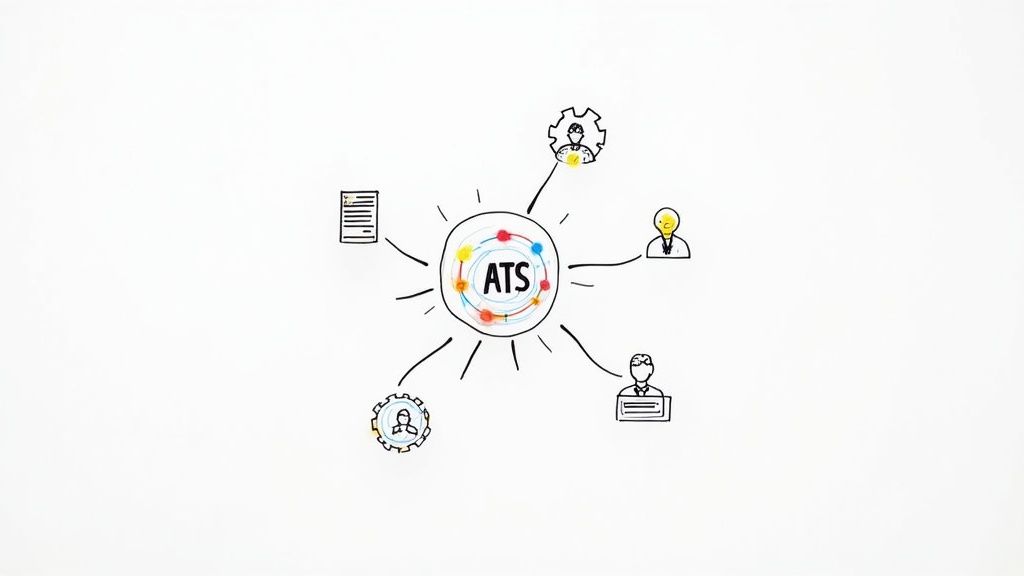 Let’s be honest, the top of the hiring funnel—sourcing—is where time goes to die. Recruiters get buried under a mountain of applications, manually sifting through resumes to find that one hidden gem. If you want to make a real impact on your hiring efficiency, this is the place to start.
Let’s be honest, the top of the hiring funnel—sourcing—is where time goes to die. Recruiters get buried under a mountain of applications, manually sifting through resumes to find that one hidden gem. If you want to make a real impact on your hiring efficiency, this is the place to start.
By bringing in some smart automation here, you free up your team to do what they do best: actually connecting with high-quality talent.
The absolute cornerstone of modern sourcing is a good Applicant Tracking System (ATS). But here’s the thing: too many companies treat their ATS like a digital filing cabinet. Resumes go in, but they never come out. To really get ahead, you need to turn that passive database into a proactive talent engine that works for you.
A well-oiled ATS does more than just hold onto applications. It acts as your first line of defense against application overload, automatically parsing, filtering, and even ranking candidates based on the criteria you set.
Turning Your ATS Into a Proactive Talent Engine
A truly optimized ATS doesn’t just sit there waiting for you to run a search. It should be actively surfacing the right people for you. You can build automated workflows that trigger specific actions—for example, a candidate with a key certification or the right number of years of experience can be automatically flagged for review or pushed to the next stage.
The impact here is huge. Getting your ATS dialed in can slash the average hiring cycle by as much as 60%. More than that, 62% of recruiters say they find better-quality candidates when they rely on an ATS instead of manual sorting.
Ready to make your ATS work harder? Here’s how:
- Automated Knockout Questions: Build specific, non-negotiable questions right into your application. If a candidate doesn’t have the legal right to work or is missing a critical license, the ATS can automatically filter them out. No more wasted time.
- Keyword-Based Filtering: Set up your system to scan resumes for must-have skills, tools, or qualifications. This is the fastest way to see who meets the baseline technical requirements for a role.
- Talent Pool Tagging: This is a game-changer. Use tags to categorize every applicant based on their skills, experience, or even how they did in a past interview. You’ll build a rich, searchable talent pool that you can tap for future openings instead of starting from scratch every single time.
A well-configured ATS does the heavy lifting, allowing your recruitment team to stop being data entry clerks and start being strategic talent partners. It shifts their focus from sorting to sourcing and engaging.
Writing Job Descriptions That Attract the Right People
Your job description is a marketing tool, plain and simple. It’s often the very first impression a candidate has of your company, and it needs to be good enough to make them hit “apply.” It also needs to be smart enough for search engines to find it.
Think of it as SEO for recruiting. Job seekers are punching keywords into job boards and Google to find their next role. If you use the right language, you’ll show up. If you use internal jargon, you’ll be invisible.
To write a job description that actually gets results:
- Use a Clear and Searchable Job Title: Ditch the cute, internal titles. No one is searching for a “Growth Hacker Ninja.” They’re searching for a “Digital Marketing Manager.” Think like a candidate.
- Focus on Impact, Not Just Tasks: Don’t just list a bunch of boring daily duties. Instead, paint a picture of what success looks like in the role. How will their work make a difference to the team and the company?
- Clearly Define “Must-Haves” vs. “Nice-to-Haves”: This helps candidates screen themselves in or out, which means fewer unqualified people in your pipeline. Just be realistic—you don’t want to scare off a great candidate who’s missing one “nice-to-have” skill.
Of course, writing a great description is only half the battle. You also need to post it in the right places. For a full rundown, check out our guide to the best remote job websites to make sure you’re targeting the right audience.
Setting Up Automated Initial Communications
What’s the biggest complaint from job seekers? The application “black hole.” They spend time on an application, send it off, and then… crickets. This is an easy fix that makes a massive difference.
Automating your initial communications is a simple, powerful way to improve the candidate experience from the get-go.
A quick, automated email confirming you’ve received their application is all it takes. It shows you respect their time and sets a professional tone. Most ATS platforms can handle this with just a few clicks.
Your automated message should include:
- A simple confirmation that their application is in your system.
- A quick overview of what to expect next.
- A rough timeline for when they might hear back.
This small step manages expectations, ensures no one feels ignored, and protects your employer brand. It leaves every single person who applies with a positive impression, whether they’re a fit or not.
Using AI for Smarter Candidate Screening
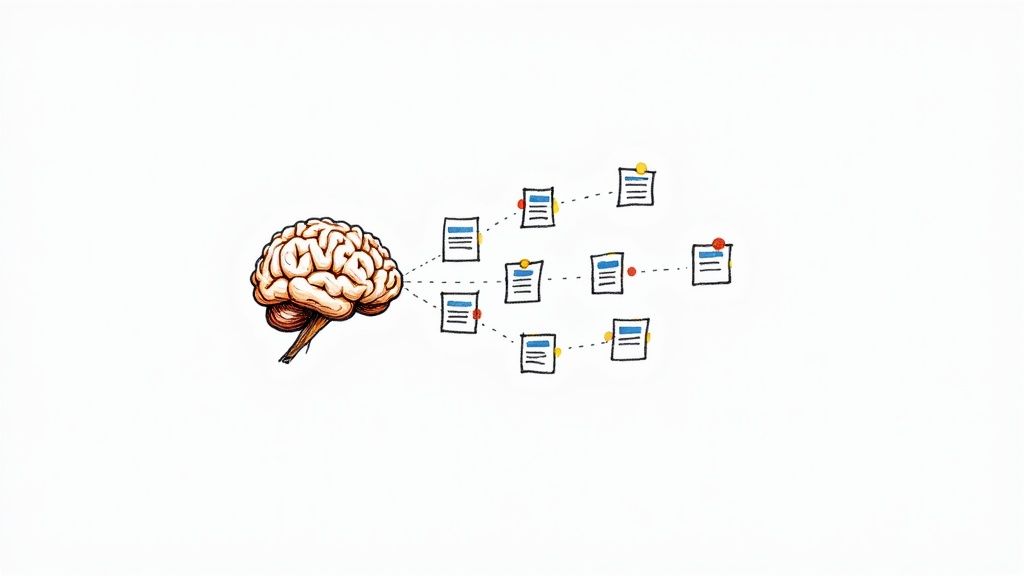 Let’s be honest: manual resume reviews are one of the biggest time-sucks in the entire hiring process. It’s slow, repetitive, and inconsistent. Great candidates often get overlooked because of simple human error or unconscious bias.
Let’s be honest: manual resume reviews are one of the biggest time-sucks in the entire hiring process. It’s slow, repetitive, and inconsistent. Great candidates often get overlooked because of simple human error or unconscious bias.
This is exactly where AI-powered screening changes everything.
By bringing artificial intelligence into the top of your funnel, you’re not replacing your recruiters. You’re upgrading them. Instead of drowning in resumes, they can focus their energy on what really matters—engaging with top-tier talent.
How AI Transforms Candidate Shortlisting
At its core, AI screening is about recognizing patterns at a scale no human team could ever match. An AI tool can tear through thousands of resumes in minutes, zeroing in on the specific skills, experiences, and qualifications you need.
It’s much smarter than simple keyword matching. Modern AI understands context and semantics, allowing it to spot high-potential candidates who might not use the exact jargon from your job description.
This approach builds a stronger, more relevant shortlist in a fraction of the time. It also adds a crucial layer of objectivity to the initial review. By basing the first pass purely on qualifications, you’re embedding fair hiring practices right into your workflow, ensuring every applicant gets an equitable look based on merit alone.
The real win with AI screening isn’t just speed; it’s precision. It helps you uncover hidden gems—candidates with killer transferable skills or unconventional backgrounds that a human reviewer might have accidentally skipped over.
Practical Ways to Use AI in Screening
This isn’t some far-off, futuristic concept. AI screening is already happening in practical ways that deliver real results. Many of the Applicant Tracking Systems you already use now have built-in AI features that automate the heavy lifting.
Here are a few powerful ways AI is being put to work today:
- Resume Parsing and Skill Matching: The tool automatically pulls key info like work history, skills, and education from every resume. It then scores each candidate against your job requirements, instantly showing recruiters who to focus on first.
- Predictive Performance Analytics: Some advanced platforms analyze the profiles of your current top performers to build a success model. The AI then hunts for similar traits in new applicants, flagging candidates who are more likely to thrive in your company’s culture.
- AI-Powered Chatbots for Initial Questions: Chatbots can engage candidates 24⁄7, answering their questions and asking basic screening questions about things like salary expectations or work authorization. It’s instant engagement for them and valuable data for you.
These tools take care of the high-volume, low-complexity tasks, freeing up your team for more meaningful, strategic work.
Filtering for Commitment with AI Assessments
One of the toughest parts of remote hiring is separating the casual “might as well apply” candidates from those who are genuinely invested. This is where AI-driven assessments and one-way video interviews are absolute game-changers.
Take structured AI interviews, for instance. These automated interviews can slash a recruiter’s workload and act as a natural commitment filter. A candidate who takes the time to complete a one-way video interview is usually more serious about the role.
Let’s walk through a real-world scenario. You’re hiring a remote customer support agent and get swamped with 500 applications.
- The Old Way: A recruiter spends days reading every single resume, trying to guess who has the right communication skills and personality. It’s slow, tedious, and highly subjective.
- The AI-Powered Way: You set up an AI-driven one-way video interview. Candidates record short answers to prompts like, “Describe a time you handled a difficult customer.” The AI can then analyze their responses for clarity, tone, and positive language, giving you a ranked list of candidates who already demonstrate strong communication skills.
The AI isn’t making the final call. It’s equipping your hiring manager with a pre-vetted pool of high-quality candidates who have already proven they’re interested and capable. Your screening process just went from a reactive chore to a proactive talent-finding machine.
Fine-Tuning Your Interview and Offer Stages
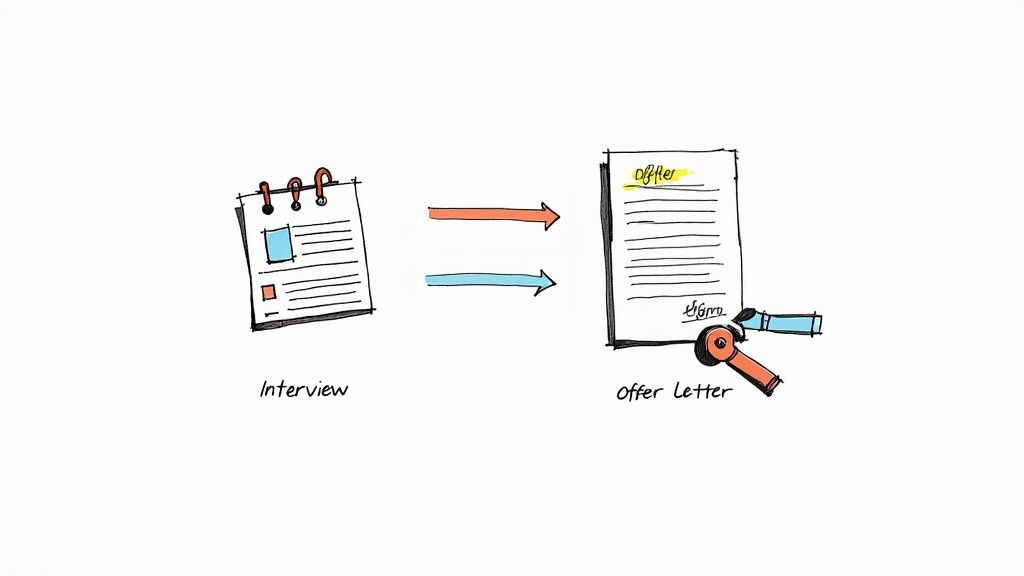
This is where so many companies drop the ball. After all that effort sourcing and screening, a clunky interview or slow offer process can send your top candidate straight to a competitor who’s faster and more organized. The final stretch is your chance to really impress, not create frustration.
The whole point here is to remove friction and build a seamless, professional experience from start to finish. Every single interaction—from the first interview request to the final signed contract—should confirm that your company is the right move. It’s a huge piece of what is candidate experience and directly impacts your ability to close the best talent.
It’s all about replacing administrative lag time with quick, confident action. When you use the right approach, the end of your hiring process can be just as compelling as the talent you’re trying to land.
Get Structured with Interviews for Fairer Decisions
Let’s be honest: “go-with-the-flow” interviews are a recipe for bias and inconsistent results. A structured interview, where every candidate for a role gets the same core set of questions, is the only way to create a level playing field.
This method ensures you’re actually comparing apples to apples. Instead of just going with a gut feeling, your team can score answers against a pre-defined rubric, keeping the focus squarely on skills and job-related abilities.
A solid structured interview kit isn’t complicated. It just needs:
- A consistent list of questions for every candidate applying for that role.
- A simple scoring guide that outlines what a great, good, or weak answer looks like.
- Clear instructions for interviewers on how to run the interview and log their feedback.
This doesn’t just lead to smarter hires; it also builds a more equitable and defensible process. It’s a fundamental practice for any team that’s serious about hiring well.
When you standardize the interview, you pull personal bias and random variables out of the equation. The focus shifts from someone’s charisma to their actual ability to do the job—which is right where it should be.
Kill the Scheduling Nightmare with Automation
Those endless email chains trying to find a time that works for three different people? They’re a colossal waste of time for everyone involved. Automating your interview scheduling is easily one of the biggest wins you can get.
Tools like Calendly or the scheduling features built into most modern ATS platforms are a game-changer. They let candidates see your team’s real-time availability and book a slot that works for them instantly. It’s a small thing that shows you respect their time and makes your company look incredibly put-together.
This simple bit of automation also keeps the momentum going. Instead of waiting days for a reply, a great candidate can be booked for their next interview just minutes after passing the previous stage.
Centralize Feedback to Make Faster Calls
Another classic bottleneck is waiting around for interviewers to type up their notes and share their thoughts. A collaborative hiring platform—something you’ll find in any good ATS—lets your team submit scorecards and feedback the second they hang up the call.
This creates a single source of truth where the entire hiring team can see feedback as it comes in. No more disjointed email threads or trying to catch people in the hallway. It enables quick, data-driven debriefs so you can make a final decision in hours, not days.
The technology here is getting pretty sharp, too. A recent report found that 74% of hiring managers believe AI can help them better assess if a candidate’s skills match the job. On top of that, 73% said AI is great for matching applicants to other open roles in the company. You can see more on how AI is changing the game in the full 2025 AI in Hiring report.
Make the Offer with Digital Simplicity
You’ve found your person. The last thing you want to do now is slow down. The offer stage needs to be fast, clear, and feel like a celebration. It’s time to ditch the clunky PDFs that have to be printed, signed, and scanned.
Modern HR platforms let you send out digital offer letters that can be reviewed and signed electronically on any device. Not only is it way faster, but it also creates a polished, professional final impression.
For the best result, pair that slick digital offer with a personal phone call from the hiring manager. That human touch goes a long way in making your top choice feel valued and excited to say yes.
Measuring Success to Continuously Improve Your Process
Streamlining your recruitment process isn’t a one-and-done project. Think of it as a living system that needs regular check-ups and fine-tuning. Without data, you’re just guessing what’s working. By measuring your efforts, you can stop the guesswork and start making targeted improvements that actually move the needle.
This is where your Applicant Tracking System (ATS) graduates from being a simple resume database into a powerful analytical tool. The right data tells the real story of your hiring funnel, showing you exactly where friction is slowing you down and costing you fantastic candidates.
Identifying Your Most Important Recruiting KPIs
You don’t need to get lost in a sea of complex charts to get started. Just focus on a few key performance indicators (KPIs) that tell the most important stories about your hiring process. These metrics give you a clear, objective view of what’s happening from the first application to the final offer.
Here are the essential KPIs I always recommend tracking:
- Time-to-Hire: This is the big one—the total number of days from when a job is first posted to when a candidate accepts your offer. A long Time-to-Hire is a major red flag, often pointing to bottlenecks in your interview or decision-making stages.
- Cost-per-Hire: This metric calculates the total cost of bringing on a new team member, factoring in everything from advertising fees to recruiter salaries and software costs. Tracking this helps you understand the financial health of your process and justify investments in better tools.
- Quality-of-Hire: This is trickier to measure but arguably the most important. It’s often tracked through a new hire’s performance reviews, manager satisfaction surveys, or their retention rate after six to twelve months.
- Candidate Satisfaction: A simple Net Promoter Score (NPS) survey sent to all applicants—yes, even the ones you rejected—provides invaluable feedback. It tells you how people perceive your brand and what it’s really like to go through your hiring process.
These four metrics provide a balanced scorecard for your entire recruitment operation. Choosing the right platform is key, and a good recruitment software comparison can help you find a tool with the robust reporting features you need.
Turning Data Into Actionable Improvements
Data is totally useless if it just sits in a dashboard. The real magic happens when you use your KPIs to diagnose problems and then test out solutions. Let’s walk through a real-world scenario to see how this plays out.
Imagine your team notices that the Time-to-Hire for engineering roles has crept up to 65 days, which you know is well above the industry average. At the same time, you see that candidate satisfaction scores for those roles are taking a nosedive. Yikes.
Instead of just telling everyone to “work faster,” you dig into your ATS data. You quickly spot a massive drop-off point: 70% of qualified candidates are withdrawing their applications right after the technical assessment stage.
Your recruitment data isn’t just a report card; it’s a treasure map. Each metric points you toward a specific area where a small change can unlock massive improvements in speed, quality, and candidate happiness.
Pinpointing and Fixing Process Bottlenecks
Now that you’ve zeroed in on the problem—the technical assessment—you can start asking why. You send a quick follow-up survey to candidates who withdrew and the feedback is eye-opening: the test is taking them over six hours to complete and feels totally disconnected from the actual day-to-day job.
Armed with this insight, you can make a specific, targeted change. You sit down with the engineering lead to redesign the assessment, cutting it down to a more reasonable two-hour task that directly mirrors a real project they would actually work on.
You roll out the new assessment and keep a close eye on the numbers. Two months later, your Time-to-Hire for engineering roles has dropped to a much healthier 42 days, and those candidate satisfaction scores have bounced back.
That’s the core of a data-driven approach: measure, analyze, act, and repeat. It’s the engine that powers continuous improvement in your hiring process.
Got Questions About Hiring? We’ve Got Answers.
Switching up your hiring process always brings up a few questions. Where do you even begin? How do you add automation without sounding like a robot? What numbers should you actually be paying attention to? Let’s clear up some of the most common hurdles that pop up when you start refining how you hire.
My goal here is to give you direct, no-fluff answers so you can stop planning and start doing.
As a Small Business, Where Do We Even Start?
For a small business, the single best thing you can do is get a basic Applicant Tracking System (ATS). Don’t worry about complex AI or fancy dashboards just yet. Your first goal is simply to get organized. There are tons of affordable, easy-to-use options that will immediately pull you out of the chaos of managing applications in spreadsheets and email threads.
An ATS brings every application into one place, sends out essential confirmation emails for you, and makes sure a great candidate doesn’t get lost in the shuffle. It solves your biggest administrative headaches right away. It also sets you up to track important metrics like time-to-fill as you grow, making it the most logical first step you can take.
How Can We Streamline Without Losing the Human Touch?
This is a big one, and it’s a valid concern. The point of streamlining isn’t to get rid of human interaction—it’s to make it better. You automate the repetitive, administrative stuff so your team has more time for meaningful, personal connections.
Here’s how to think about it:
- Let Automation Handle Logistics: Use your tools to send that first “we got your application” email, manage interview scheduling links, and provide simple status updates. This keeps everyone in the loop without you lifting a finger.
- Let Humans Handle Relationships: With all that new time back, your team can dig deeper in interviews, build real rapport with your top contenders, and give genuinely helpful feedback to the people you don’t hire.
Technology should run the process so your people can build the relationships. This approach doesn’t just preserve the human touch; it makes every conversation more impactful.
What Are the Most Important Metrics to Track?
You can track dozens of recruiting metrics, but trying to watch everything at once is a recipe for analysis paralysis. It’s far better to start with a few KPIs that tell you the biggest story about the health of your hiring funnel.
When you’re starting out, just focus on these three:
- Time-to-Hire: This is the clock running from the day a job goes live to the day an offer is signed. It’s the ultimate measure of your overall efficiency. If this number is consistently high, you’ve got a bottleneck somewhere.
- Source of Hire: This tells you exactly which channels—be it a specific job board, employee referrals, or a social media campaign—are actually delivering the candidates you end up hiring. It’s how you know where to invest your time and money for the best results.
- Candidate Satisfaction: A quick, simple survey sent to every applicant (both hired and not) gives you a raw look at their experience. This is a powerful leading indicator of your employer brand’s health.
Keeping an eye on just these three numbers will give you a clear, data-driven picture of what’s working and what needs fixing. It’s the smartest way to make sure your efforts are actually paying off.
Ready to stop losing top talent to a slow, clunky hiring process? Remote First Jobs connects you with thousands of qualified candidates actively looking for their next remote role. Post your job today and build your high-performing team, faster. Find your next great hire at https://remotefirstjobs.com.
